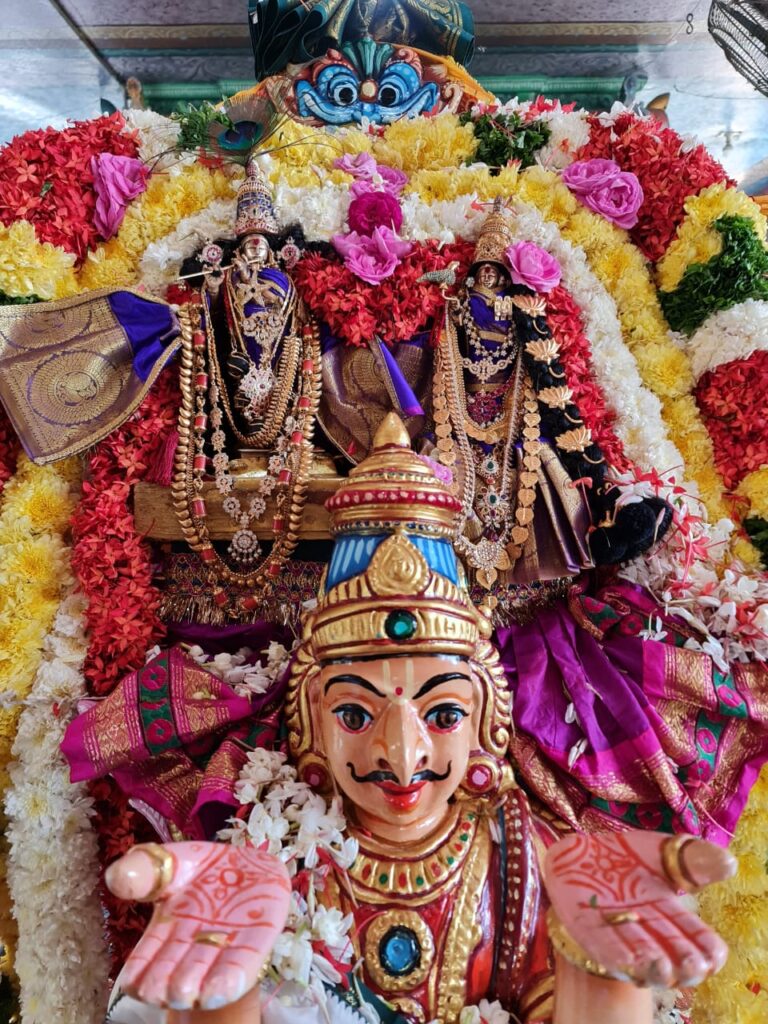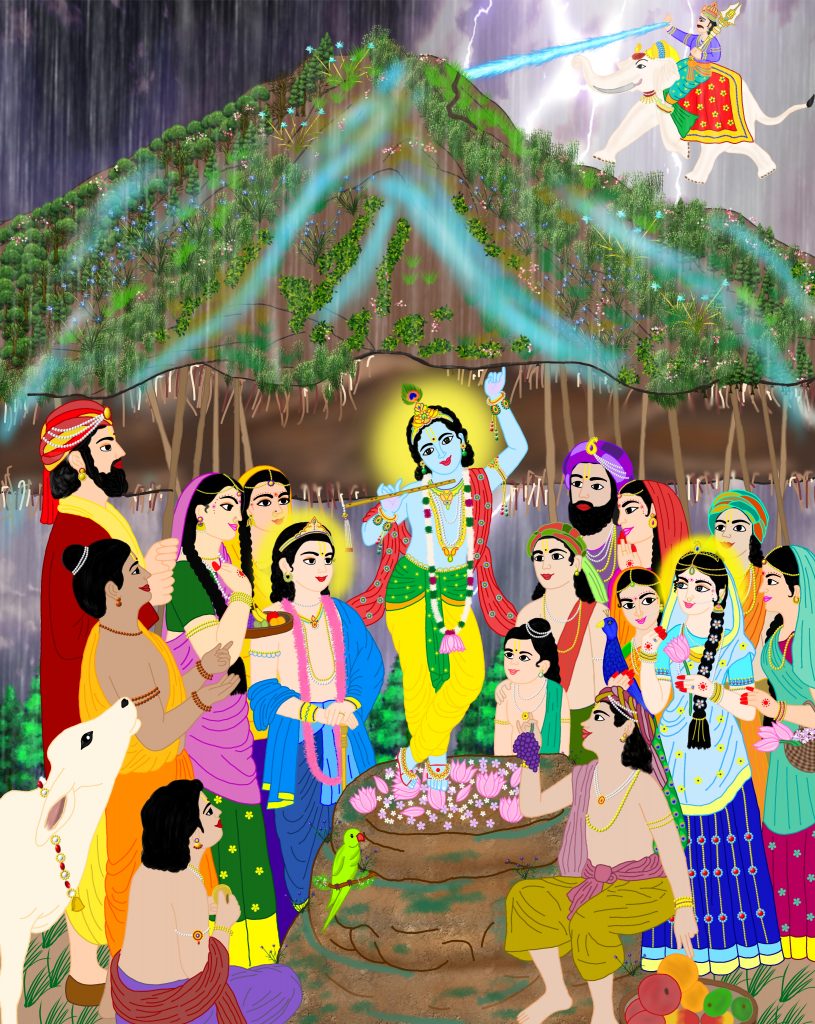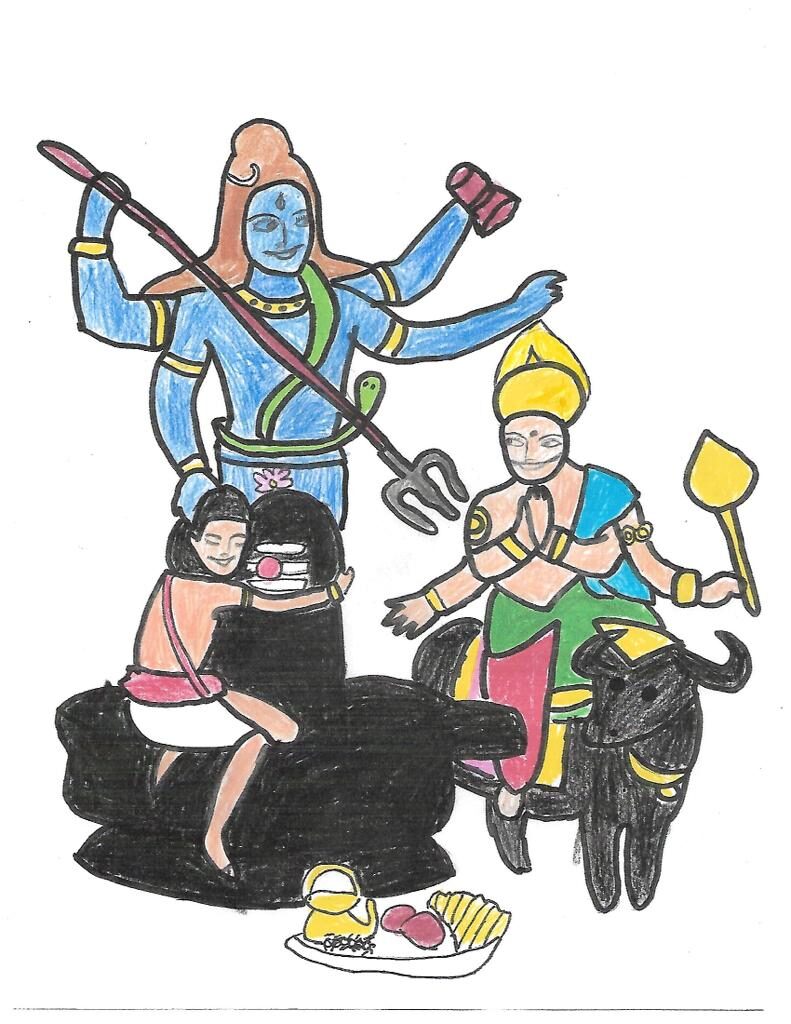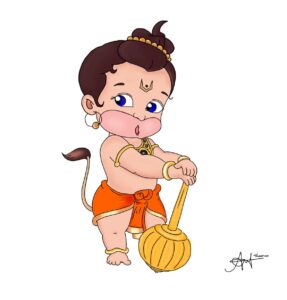In our previous episodes of ‘Sri Madhurageetham Quelish’, we enjoyed the rasa in various Sri Madhurageethams laden with different poetic embellishments like ‘dhvani’ (suggestiveness) – where the implied meaning is not apparent but has to be discerned; ‘sandeha’ (doubt) and ‘brAnti’ (mistaken notion) – ornamentations that add unique beauty to the mood of the song; ‘Ninda Stuti‘ – another interesting adornment to a composition where the poet apparently censures while intending to praise; ‘upamA’ (simile) – yet another beautiful literary frill stitched in a composition and so on. This month we shall relish one such quelish which involves an ‘indirect comparison.’
Our ‘question to relish’ (quelish) this time is – In which song has our Sri Swamiji indirectly compared the heart of our Bhagavan Krishna to a beautiful flower?
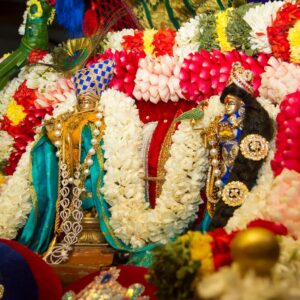
Ancient poets, scholars and Mahatmas have drawn poetic pictures of Bhagavan Sri Krishna and Radha Devi by comparing Their enchanting forms, qualities and greatness to those of certain flowers, the cool rays of the moon, rain-bearing clouds to name a few. In our scriptures, the lotus is often very fondly connected with Bhagavan Krishna.
In Srimad Bhagavatham, Kunti Devi praises Bhagavan by singing,
“namah pankaja-nAbhAya namah pankaja mAline
namah pankaja netrAya namas te pankajAnghraye” SB – 1.8.22
“My respectful obeisances to You, O Lord, whose navel seems adorned with a lotus flower, who is always decorated with garlands of lotus flowers, who possesses lotus-like eyes and whose Feet resemble the lotus.”
Sri Swamiji, in many of his Madhurageethams, has drawn similar connections as well. In one of his kirtans on Lord Panduranga, He praises Lord Panduranga as One adorned with lotus-like eyes (pankajalOchana pANDuranga), One garlanded with lotus flowers (pankajamAlee pANDuranga) and One with a lotus-like navel (pankajanAbha pANDuranga).
Mahatmas also adore Bhagavan Krishna as possessed with a nose as sharp as the champaka flower. In the Madhurageetham, ‘Vandanamasthu te Vamshidhara’, Sri Swamiji sings “champakanAsika vamshIdhara“, showing a beautiful comparison of His nose to that of the sacred champaka flower.
Our Sri Swamiji, in this incredibly delicate and lovely Madhurageetham, ‘Ati Ascharya Kataksham’ , does an indirect comparison of Bhagavan Sri Krishna’s heart to another very exquisite flower.
Upama alankara in Sanskrit literature has primarily two main elements – The object of comparison (upamAna) and the subject of comparison (upameya). These are the key terms that discern the rasa of the poetic expression. Indirect comparison in a composition can arise when the subject of comparison is evident but the standard of comparison has to be comprehended based on the cues in the composition and vice versa .
In this kirtan, Sri Swamiji describes our Swamini, Madhurisakhi, as the golden bee decorating Bhagavan’s heart (sundara prEmikavarada hridaya bhringi) and thereby indirectly conveying that Bhagavan’s heart is a nectarine flower. As Bhagavan’s heart is often compared to a lotus, we might immediately imagine that a lotus flower is what Sri Swamiji means here.
However, the second line of the charanam beginning, “sundara chandrasamAna sumukhi” throws a lovely flavor and depth into the real expression contained in the composition. He sings that our Swamini’s countenance is like a lovely full moon (sundara chandrasamAna sumukhi) and so the object of comparison – the heart of Bhagavan here – is actually a nectarine lily flower. Lilies bloom at night, awakened by the gentle soothing moon rays. Hence, the calming cool rays from the moon-like face of Shri Radha Devi is the reason for Bhagavan’s heart, the lily, to bloom and She further Herself also becomes the golden bee relishing and permeating the sweetness of the nectarine lily (heart).
PremikaVaradan also owes His beauty (sundara prEmikavarada) to our Swamini, Madhurisakhi, who as a golden streak (hiraNmayI) decorates Bhagavan’s divine chest and who also being hLAdini shakti – the inseparable shakti of divine bliss, permeates so much sweetness and joy.
Residing in His heart, Sri Swamiji says, the Divine Mother by Her extraordinary divine glance (ati Ascharya kaTAkSham) bestows all the four fruits of this life and also grants liberation instantly and effortlessly (chaturvida puruShArttham vA chaturvida muktimvA, sadyO dadAti anAyAsEna tava kaTAkSham rAdhE).
Many Mahatmas and Azhwars have extolled the greatness of Divine Mother’s compassionate glance in their eminent works.
Swami Desikan in his Sri Stuthi glorifies Her benevolent glance saying,
Wherever the beautiful glance of Mahalakshmi Devi falls, richness showers in all directions and the various riches (sampadOghA:) blessed by Her compassionate glance compete with each other to take the first place (yasyAm yasyAm dishi viharate devi drushTisvadhyAh tasyAm tasyAmahamahamikAm tanvate sampadOghAh).
In yet another work called ‘Daya Shatakam’ Swami Desikan says Mother Sri Devi is the very embodiment of compassion. She is a mother to all and vows to remain inseparable from the vast expansive divine chest of Perumal so that without fail and exception Srinivasa Perumal bestows mercy upon all always.
Nammazhwar celebrates this infinite compassion of our Divine Mother in his pasuram saying,
“aghalagillEn iRaiyumenRu alarmEl mangai uRai maarbhA!” – “I shall never even for a fleeting second move away from Srinivasa Perumal’s chest.” Saying so, She remains, casting Her compassionate divine glance which transcends space (desha), time (kAla) and individual (vyakti).
The great Sri Vaishnava Acharya, Sri Parashara Bhattar, seeing the Mohini alankaram of Bhagavan Sri Ranganathar during the procession says that Bhagavan, despite being very beautifully dressed with a grand silk garment, bedecked with jewels, nicely decorated, neatly plaited long hair strung with beautiful fragrant garlands, cannot compete with Thayar’s beauty because the compassionate glance that flows from Divine Mother’s eyes is very special and unique to Her only!
Such is the greatness of Divine Mother’s lovely glance. Sri Swamiji completes the song with the line, “sundara mahAraNya rAjamAtangi”. Despite many grander and bigger destinations in the world, nevertheless devotees flock to Madhurapuri, verily because it is an abode of divine beauty and abundance – our Swamini Madhurisakhi Herself being the epitome of prosperity (samruddhi) here.
Sri Ramanujamji in his exposition of this quelish explains that Thakurji (Premikavaradan) is the reason for the ‘mahA’ in ‘mahAranyam’ and our Swamini (Madhurisakhi) is the reason for it being ‘sundara’ – ‘beautiful Maharanyam.’ She rules with her unmatched divine love over both MahAranyam and our beloved Premikavaradan.
Such is the incredible loveliness of this divine poetic expression which we shall enjoy this month.
rAgam: sArangA
thALam: Adi
Pallavi
ati Ashcharya kaTAkSham
tava kaTAkSham rAdhE
Anupallavi
chaturvida puruShArttham vA chaturvida muktimvA
sadyO dadAti anAyAsEna tava kaTAkSham rAdhE
charaNam
sundara prEmikavarada hridaya bhringi
sundara chandrasamAna sumukhi
sundara gauravarNa lathAngi
sundara mahAraNya rAjamAthangi
Meaning
Pallavi
Oh what a highly extraordinary glance,
Is Thy glance, O Radhe!
Anupallavi
Be it the four kinds of fruits of both this life and beyond (liberation),
Effortlessly and immediately Thy glance bestows, O Radhe!
Charanam
O bee of beautiful Premikavarada’s heart,
O One with a beautiful moon-like face,
O beautiful fair creeper,
O Queen of the bountiful and beautiful Maharanya kshetra
Based on Sri Ramanujamji’s insights into the Sri Madhurageetham
Compiled by Nithya Balasubramanian, Pleasanton, CA
************************************
Click here to go back to the May 2022 newsletter page:
https://godivinity.org/newsletters/nama-dwaar-newsletter-may-2022/
************************************
